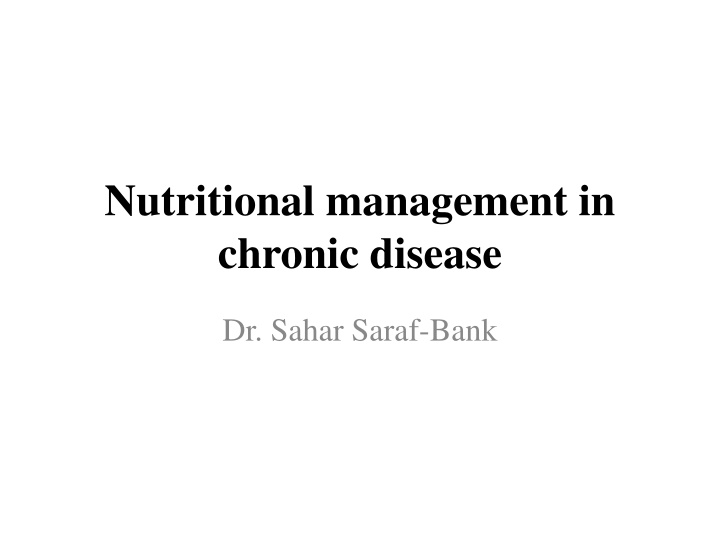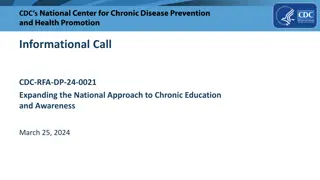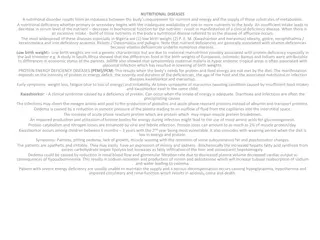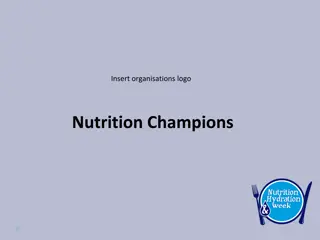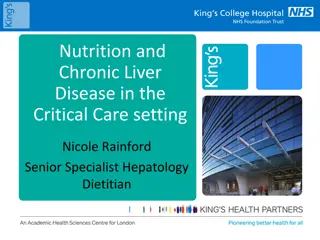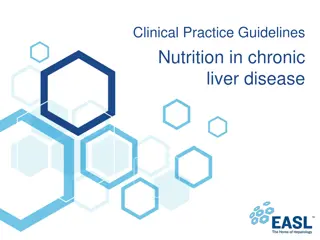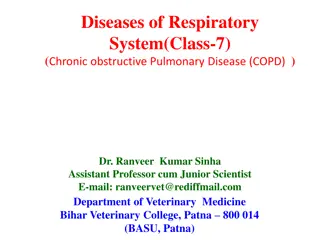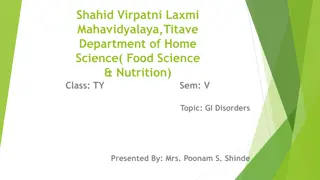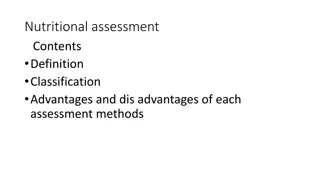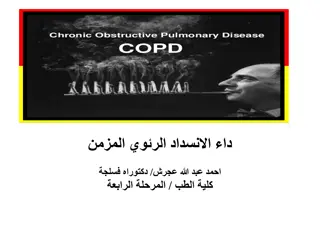Nutritional Management in Chronic Disease
Chronic diseases are a significant global health concern, with nutrition playing a key role in prevention and management. This article explores the importance of healthy diets in conditions like diabetes, cardiovascular disease, cancer, and chronic kidney disease, highlighting individualized nutrition therapy, lifestyle improvements, and relevant outcomes.
Download Presentation

Please find below an Image/Link to download the presentation.
The content on the website is provided AS IS for your information and personal use only. It may not be sold, licensed, or shared on other websites without obtaining consent from the author.If you encounter any issues during the download, it is possible that the publisher has removed the file from their server.
You are allowed to download the files provided on this website for personal or commercial use, subject to the condition that they are used lawfully. All files are the property of their respective owners.
The content on the website is provided AS IS for your information and personal use only. It may not be sold, licensed, or shared on other websites without obtaining consent from the author.
E N D
Presentation Transcript
Nutritional management in chronic disease Dr. Sahar Saraf-Bank
Introduction Chronic diseases are the leading cause of death and disability and account for 60% of all deaths worldwide Several health agencies have recommended the adoption of a healthy diet as the cornerstone in the prevention and/or management of chronic diseases such as cardiovascular diseases, diabetes, cancer
Nutritional management in chronic disease Diabetes Cardiovascular disease Cancer Chronic kidney disease
Diabetes Nutrition therapy (NT) is integral to total diabetes care and management. NT requires an individualized approach and effective nutrition, self- management education, counseling, and support. Monitoring glucose, A1C and lipid levels, blood pressure, weight, and quality-of-life issues is essential in evaluating the success of nutrition-related recommendations. Since T2DM is a progressive disease, nutrition and physical activity interventions alone (i.e., without medications) are generally not adequate in maintaining glycemic control overtime.
Diabetes Goals and desired outcomes Emphasize the role of lifestyle in improving glucose control, lipid and lipoprotein profiles, and blood pressure. Improving health through food choices and physical activity is the basis of all nutrition recommendations for the treatment of diabetes. The effect of NT on A1C will be known by 6 weeks to 3 months, at which time the dietitian must assess whether the goals of therapy have been met by changes in lifestyle or not.
Diabetes Goals and desired outcomes A common focus of MNT for individuals with T2DM is reduced energy intake. Additionally, MNT may encourage the consumption of dietary fiber from fruit, vegetables, whole grains and legumes due to their overall health benefits. Sodium may also be a nutrient of focus. The recommendation for the general public to reduce sodium to <2300 mg/day is also appropriate for people with diabetes. However, if the individual has both diabetes and hypertension, additional reductions in sodium intake may be indicated
Diabetes Energy balance and weight Overweight and obesity are common in people both at risk for and with T2DM Some research suggests that reduced calorie intake can lead to reductions in A1C of 0.3% to 2.0% in adults with T2DM. If appropriate for the individual, a reduction in caloric intake may also lead to improvements in medication doses and quality of life.
Diabetes Energy balance and weight Similarly, weight loss interventions implemented in people with pre- diabetes and newly diagnosed with T2DM have been shown to be effective in improving glycemic control The problem is that weight loss diets are not sustainable. A review of over 30 long-term studies concluded that the more diets an individual has tried, the more weight they regain Approximately half of the weight loss intervention studies in people with T2DM improved A1C at 1 year and one-half did not Weight losses greater than 5% resulted in consistent improvements in A1C, lipids, and blood pressure; weight losses less than 5% did not result in consistent 1-year improvements in A1C, lipids, or blood pressure
Diabetes Energy balance and weight Therefore the dietitian should collaborate with individuals who have diabetes to integrate nutrient-dense eating patterns (which may or may not lead to weight loss) and regular physical activity and should not make assumptions on eating habits and lifestyle patterns based on weight.
Diabetes Macronutrient percentages and eating patterns Although numerous studies have attempted to identify the optimal percentages of macronutrients for the eating plan of persons with diabetes, review of the evidence shows clearly that there is not an ideal percentage of calories from carbohydrate, protein, and fat for all persons with diabetes Macronutrient distribution should be based on an individualized assessment of current eating patterns, preferences, and metabolic goals (lipid profile, renal function)
Diabetes Macronutrient percentages and eating patterns Although numerous factors influence glycemic response to foods, monitoring total grams of carbohydrates, whether by use of carbohydrate counting or experienced based estimation, remains a key strategy in achieving glycemic control While some evidence suggests that the type of carbohydrate eaten may influence blood glucose levels, the total amount of carbohydrate eaten is the primary predictor of glycemic response. In people with T1DM or T2DM who are on insulin pump therapy, insulin doses should be adjusted to match carbohydrate intake
Diabetes Carbohydrate intake Low-carbohydrate diets may seem to be a logical approach to lowering postprandial glucose. However, foods that contain carbohydrates (whole grains, legumes, fruits, vegetables, and low-fat milk) are excellent sources of vitamins, minerals, dietary fiber, and energy and are encouraged over other sources of carbohydrates to improve overall nutrient intake The long-held belief that sucrose also known as common table sugar must be restricted based on the assumption that sugars are more rapidly digested and absorbed than starches is not justified. The total amount of carbohydrate eaten at a meal, regardless of whether the source is starch or sucrose, is the primary determinant of postprandial glucose levels.
Diabetes Carbohydrate intake The glycemic effect of carbohydrate foods cannot be predicted based on their structure (i.e., starch vs. sugar) owing to the efficiency of the human digestive tract in reducing starch polymers to glucose. Starches are rapidly metabolized into 100% glucose during digestion, in contrast to sucrose, which is metabolized into only approximately 50% glucose and approximately 50% fructose. Fructose has a lower glycemic response, which has been attributed to its slow rate of absorption and its storage in the liver as glycogen. However, care should be taken to avoid excess energy intake and to avoid displacing nutrient-dense food choices
Diabetes Glycemic index and glycemic load The glycemic index (GI) of food was developed to compare the physiologic effects of carbohydrates on glucose. The GI ranks carbohydrate foods according to how they affect blood glucose levels (for example, the GI of glucose = 100; the GI of white bread = 70). The estimated glycemic load (GL) of foods, meals, and dietary patterns is calculated by multiplying the GI by the amount of available carbohydrate (divided by 100) in each food and then totaling the values for all foods in a meal or dietary pattern For example, two slices of white bread with a GI of 75 and 30 g of carbohydrate has a GL of 22.5 (75 30/100 = 22.5)
Diabetes Glycemic index and glycemic load The ADA found that studies longer than 12 weeks report no significant impact of GI or GL, independent of weight loss, on A1C. However, mixed results were reported regarding fasting glucose levels and endogenous insulin levels. If GI or GL is proposed as a glycemia-lowering strategy, the dietitian can advise adults with diabetes that lowering the GI or GL may or may not have a significant effect on glycemic control.
Diabetes Fiber and whole grains There is evidence to suggest that dietary fiber intake may lead to decreased all-cause mortality in individuals with diabetes A meta-analysis found that an intervention involving fiber supplementation for T2DM can reduce fasting blood glucose (FBG) and A1C (0.26%). consuming 25 g fiber per day for adult women and 38 g per day for adult men is encouraged It is also recommended that individuals with diabetes consume at least half of all grains as whole grains
Diabetes Relevance of the Glycemic Index and Glycemic Load for Body Weight, Diabetes, and Cardiovascular Disease An equivocal relationship between glycemic index /glycemic response and disease outcome The strongest intervention studies typically find little relationship among GI/GR and physiological measures of disease risk. It is unlikely that the GI of a food or diet is linked to disease risk or health outcomes. Other measures of dietary quality, such as fiber or whole grains may be more likely to predict health outcomes. Thus, focusing on overall dietary quality and promoting the healthful aspects of the diet (e.g., dietary fiber and fruit and vegetable intake) may be a better approach to help reduce chronic disease risk. Vega-L pez, Nutrients. 2018 Sep 22;10(10):1361. doi: 10.3390/nu10101361.
Cardiovascular Disease Nutrition therapy (NT) is the primary intervention for patients with elevated LDL cholesterol With diet, exercise, and weight reduction, patients can decrease LDL cholesterol and reduce body inflammation.
Cardiovascular Disease Lifestyle recommendations The AHA recommends diet and lifestyle changes to reduce ASCVD (atherosclerotic cardiovascular disease) risk in all people older than the age of 2 A diet high in vegetables, fruits, whole grains, low-fat poultry, fish, non-tropical vegetable oils, nuts, and low-fat dairy and low in sweets, sugar-sweetened beverages, and red meat
Cardiovascular Disease Saturated fatty acids The recommendation for decreasing LDL cholesterol is 5% to 6%. The guidelines have no specific recommendation for trans fatty acid intake but recommend it be decreased with the saturated fat. Saturated fat is generally found in animal proteins. It is recommended that intake of animal protein, especially red meat and high-fat dairy, be decreased. Many studies emphasize that the association between SFA and CVD risk may depend on its dietary source Meat and dairy products
Cardiovascular Disease Trans fatty acids Trans fatty acids are produced in the hydrogenation process used in the food industry to increase shelf life of foods and to make margarines, made from oil, firmer. Most trans fatty acids intake comes from these partially hydrogenated oils (PHOs). Trans fats contributed to ASCVD and was associated with increased LDL cholesterol levels. Trans fat intake is inversely associated with HDL levels
Cardiovascular Disease Monounsaturated fatty acids. Substituting oleic acid for carbohydrate has almost no appreciable effect on blood lipids. However, replacing saturated fatty acids (SFAs) with MUFAs (as would happen when substituting olive oil for butter) lowers serum cholesterol levels, LDL cholesterol levels, and triglyceride levels. Oleic acid has been shown to have anti-inflammatory effects. Olive oil, Nuts such as almonds, Canola oil, Avocados.
Cardiovascular Disease Polyunsaturated fatty acids. The first double bond in the fatty acid carbon chain ( -3 and -6 PUFAs) The effects of essential fatty acid linoleic acid (LA; omega 6) depends on the total fatty acid profile of the diet Large amounts of LA decrease HDL serum cholesterol levels. High intakes of omega-6 PUFAs may exert adverse effects on the function of vascular endothelium or stimulate production of proinflammatory cytokines However, the AHA does not support concern for omega-6 PUFAs as proinflammatory Fats and oils, meat and poultry, cereal-based products, vegetables, and nuts and seeds
Cardiovascular Disease Omega-3 fatty acids. The main omega-3 fatty acids (eicosapentaenoic acid [EPA] and docosahexaenoic acid [DHA]) are high in fish oils, fish oil capsules, and ocean fish (salmon, tuna, sardines). Some studies have shown that eating fish (3.5-ounce serving twice a week.) is associated with a decreased ASCVD risk interfere with blood clotting and alter prostaglandin synthesis; stimulates production of NO, a substance that stimulates vasodilation
Cardiovascular Disease Omega-3 fatty acids. Consumption of omega-3 fat in the form of fish oil has been associated with higher levels of HDL cholesterol and lower levels of serum triglycerides An omega-3 fatty acid from vegetables, alpha- linolenic acid (ALA), has anti-inflammatory effects Unfortunately, high intakes (above 3 g EPA/DHA) prolong bleeding time.
Fatty Acids Composition of Vegetable Oils and Its Contribution to Dietary Energy Intake and Dependence of Cardiovascular Mortality on Dietary Intake of Fatty Acids Jana Orsavova, Ladislava Misurcova, Jarmila Vavra Ambrozova, Robert Vicha, Jiri Mlcek Int J Mol Sci. 2015 Jun; 16(6): 12871 12890. Published online 2015 Jun 5. doi: 10.3390/ijms160612871
Fatty acid composition of vegetable oils grape 10.4 14.8 74.9 sunflower 9.4 28.3 62.4 0.2 62.2 wheat germ 18.2 20.9 61 1.2 59.7 sesame 16.9 42 41.2 0.2 40.9 rice bran rapeseed olive 22.5 6.3 44 72.8 33.6 20.9 0.5 1.2 33.1 19.6 SFA MUFA PUFA Omega 3 0.2 Omega 6 74.7 19.4 68.2 18 1.6 16.4 Fatty Acids Composition of Vegetable Oils and Its Contribution to Dietary Energy Intake and Dependence of Cardiovascular Mortality on Dietary Intake of Fatty Acids Jana Orsavova, Ladislava Misurcova, Jarmila Vavra Ambrozova, Robert Vicha, Jiri Mlcek Int J Mol Sci. 2015 Jun; 16(6): 12871 12890. Published online 2015 Jun 5. doi: 10.3390/ijms160612871
Cardiovascular Disease Dietary cholesterol. Previous recommendations have been to decrease dietary cholesterol to decrease LDL cholesterol and reduce ASCVD risk. The AHA 2013 guidelines no longer make this recommendation, and they specifically state that dietary cholesterol does not raise LDLs The 2015 U.S. Dietary Guidelines also eliminate the recommendation to restrict cholesterol. However it is important to remember that most high cholesterol foods are also high in saturated fats that do raise LDL cholesterol.
Cancer Nutrition therapy (NT) improves treatment tolerance, reduces the need for breaks in treatment, decreases unintentional weight and lean body mass loss, and can improve quality of life. Nutrition therapy has been shown to decrease unplanned hospitalizations by >50%, reduce length of hospital stays, and improve overall survival for patients undergoing cancer treatment.
Cancer Energy Not every person who undergoes cancer treatment will lose weight. In fact, some may gain, so energy adjustments should be made to support a healthy weight depending on the unique needs of each individual Individual s diagnosis, presence of other diseases, intent of treatment (e.g., curative, control, or palliation), therapies (e.g., surgery, chemotherapy, biotherapy, or radiation therapy), presence of fever or infection, and other metabolic complications such as refeeding syndrome
Cancer Protein An individual s need for protein is increased during times of illness and stress. Additional protein is required by the body to repair and rebuild tissues affected by cancer treatments and to maintain a healthy immune system The degree of malnutrition, extent of disease, degree of stress, and ability to metabolize and use protein are factors in determining protein requirements
Cancer Prevalence of malnutrition and impact on clinical outcomes in cancer services: A comparison of two time points Kathryn M Marshall, Clin Nutr .2019 Apr;38(2):644-651. doi: 10.1016/j.clnu.2018.04.007.
Cancer Prevalence of malnutrition and impact on clinical outcomes in cancer services: A comparison of two time points Malnutrition was associated with: Older age, 5% weight loss, hospital admission and metastatic disease. Malnutrition was associated with infection and poor outcomes (readmission and death) at 30- days.
Cancer Fluid Dietitians managing cancer patients must ensure adequate hydration and electrolyte balance to prevent dehydration and hypovolemia. Altered fluid balance may occur with fever, ascites, edema, fistulas, profuse vomiting or diarrhea, multiple concurrent intravenous (IV) therapies, impaired renal function, or medications such as diuretics dehydration (e.g., intracellular fluid losses caused by inadequate intake of fluid because of mucositis or anorexia), hypovolemia (e.g., extracellular fluid losses from fever or GI fluids such as vomiting, diarrhea, or malabsorption), and nephrotoxic effects from anticancer treatments.
Cancer Nutrition screening and assessment Validated screening tools Careful review of the individual s appetite and oral intake is required, with an assessment of symptoms (e.g., nausea, vomiting, and diarrhea), weight status, comorbidities, and laboratory studies. Recommendations should be prioritized with input from the patient. Patients have highly variable side effects with cancer treatment that can effect their energy level, mood, and tolerance of foods
Cancer Micronutrients For patients undergoing cancer treatment, micronutrient status may be affected by the severity of illness, type of treatment, location type of tumor, and ability to consume a normal diet. If individuals are experiencing difficulty with eating and treatment-related side effects, a standard multivitamin and mineral supplement that provides no more than 100% of the DRIs is considered safe To date, vitamin and mineral supplements have not proven effective for cancer prevention. American Institute for Cancer Research encourages all people including cancer survivors not to use dietary supplements for cancer prevention because evidence is insufficient to assess the potential benefits versus harm of doing so
Cancer Micronutrients There are some emerging exceptions: calcium supplements showed a probable decreased risk for colorectal cancer omega-3 supplements up to 2 grams/day have shown antitumor activity and reduced neuropathy In some instances, during and after a cancer diagnosis, supplementation or restriction of specific micronutrients may be required above or below DRI levels, depending on medical diagnosis and laboratory analysis iron supplementation for iron-deficiency anemia, B12 injections, and folic acid supplementation during treatment with the chemotherapy agent pemetrexed ([Alimta]
Cancer Micronutrients There is evidence that some supplements may be harmful before or during treatment. Food sources of antioxidants are safe, but some supplemental forms of antioxidants have proven ill effects. For example, high-dose beta-carotene supplements in people who smoke have been shown to increase the risk of lung cancer Patients treated with cyclophosphamide should avoid taking curcumin until more data can clear potential antagonistic interactions shown in a laboratory setting. Although drinking green tea is safe, studies on green tea extracts are mixed and carry the risk of potential liver damage at very high doses. Vitamin C can cause GI distress and is still under investigation for efficacy and potential for reducing chemotherapy cytotoxicity
Chronic Kidney Disease The mortality rate of predialysis adult patients cared for by a dietitian was 19% lower in comparison to those who did not receive this care It seems that nutritional treatment in early stages of CKD may prolong life The primary objectives of NT are to manage the symptoms associated with the syndrome by treating the primary cause of the disease and then the secondary symptoms (edema, hypoalbuminemia, and metabolic acidosis), decrease the risk of progression to renal failure, decrease inflammation, and maintain nutritional stores
Chronic Kidney Disease Protein. The diet should attempt to provide sufficient protein and energy to maintain a positive nitrogen balance and to support tissue synthesis while not overtaxing the kidneys. In most cases, sufficient intake from carbohydrate and fats is needed to spare protein for anabolism. The recommended dietary protein level for CKD patients has changed over time. Historically, these patients received diets low in protein to prevent symptoms of uremia prior to the development of dialysis. Studies have shown that a reduction of protein intake to 0.8 g/kg/day (50% HBV) may decrease proteinuria without adversely affecting serum albumin.
Chronic Kidney Disease Protein Systemic hypertension, which aggravates the progressive loss of renal function, must be well controlled to produce benefits from protein restriction. Also important in the control of the progression of renal failure in people with diabetes is good blood glucose control. In a national multicenter trial, it is shown that blood glucose control was more important than protein restriction in delaying the onset of renal failure in individuals who have diabetes.
Chronic Kidney Disease Individuals in the highest quartile of the weighted healthy lifestyle score (diet, physical activity, BMI, and smoking) had a 53% lower risk of death compared with those in the lowest quartile Healthy diet, including high intake of vegetables, fruits, nuts, whole grains, legumes, and fish and low in saturated fat and sodium was associated with lower rates of age-adjusted all-cause mortality A plant-based diet was shown to influence survival through improvement of metabolic acidosis and blood pressure, reduced urine parameters of kidney injury, decreased the production of potential uremic toxins through the alteration of gut flora, diminished body weight, and improved cardiovascular outcomes
Chronic Kidney Disease High consumption of sugary drinks/sodas has been demonstrated to be associated with the incidence of albuminuria, and faster GFR decline in the community A low-fructose diet reduced inflammatory biomarkers levels and blood pressure
